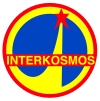| Интеркосмос Космическая Программа Interkosmos Kosmicheskaya Programma | |
 Interkosmos patch | |
| Program overview | |
|---|---|
| Country |
|
| Organization |
|
| Purpose | crewed and uncrewed space mission for Soviet allies |
| Status | Completed |
| Program history | |
| Duration | 1967–1994 |
| First flight |
|
| First crewed flight |
|
| Last flight |
|
| Launch site(s) | Baikonur |
| Part of a series of articles on the |
| Soviet space program |
|---|
Interkosmos (Russian: Интеркосмос) was a Soviet space program, designed to help the Soviet Union's allies with crewed and uncrewed space missions.
The program was formed in April 1967 in Moscow.[1][2] All members of the program from USSR were given the Hero of the Soviet Union medal or the Order of Lenin. The program included the allied east-European states of the Warsaw Pact, Eastern Bloc, CoMEcon, and other socialist states like Afghanistan, Cuba, Mongolia, and Vietnam. In addition, pro-Soviet non-aligned states such as India and Syria participated,[3][4] and even states such as the United Kingdom, France and Austria, despite them being capitalist states.[5][6]
Following the Apollo–Soyuz, there were talks between NASA and Interkosmos in the 1970s about a "Shuttle-Salyut" program to fly Space Shuttle missions to a Salyut space station, with later talks in the 1980s even considering flights of the future Buran-class orbiter to a future US space station.[7] Whilst the Shuttle-Salyut program never materialized during the existence of the Soviet Interkosmos program, after the dissolution of the Soviet Union the Shuttle–Mir Program would follow in these footsteps in the mid-1990s and eventually pave the way to the International Space Station.
Beginning in April 1967 with unpiloted research satellite missions, the first crewed Interkosmos mission occurred in February 1978.[6] So called joint crewed spaceflights enabled 14 non-Soviet cosmonauts to participate in Soyuz space flights between 1978 and 1988. The program was responsible for sending into space the first citizen of a country other than the USA or USSR: Vladimír Remek of Czechoslovakia.[5] Interkosmos also resulted in the first black and Hispanic person in space, Arnaldo Tamayo Méndez of Cuba, and the first Asian person in space, Phạm Tuân of Vietnam. Of the countries involved, only Bulgaria sent two cosmonauts in space, although the second one did not fly under the Interkosmos program, and the French spationaut Jean-Loup Chrétien flew on two separate flights.[8]
The Soviet Union also made offers of joint human spaceflight on a commercial basis to the United Kingdom and Japan resulting in the first British and Japanese cosmonauts. In the early 1980s, an offer was made to Finland as well, with test pilot Jyrki Laukkanen mentioned as one of the potential Finnish cosmonauts. The pilots of the Test Flight (Koelentue) refused on the grounds that participation would not benefit the Flight or test pilot activity in any way. No further offers were made to Finland regarding the matter.[9][10]










































